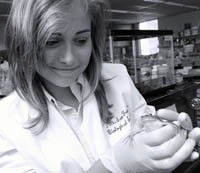Burning Calories: Cashews on Fire

Greetings, fellow "Science Buddies!" My name is Maddy, and I am working this summer for Science Buddies testing project ideas that appear in their directory of more than 1000 science projects. I've been testing anywhere from 5-12 projects a week, so I am constantly busy making messes "in the name of science."
My favorite project this week was Burning Calories: How Much Energy is Stored in Different Types of Food? The basic goal of this project from the Cooking & Food Science interest area is to build a homemade calorimeter to determine the energy (measured in calories) found in foods like cashews, marshmallows, crackers, and even dog food.
The project idea seemed interesting and straightforward to execute, so I dug up some aluminum cans, assembled my food items, and got to work. Of course, the opportunity to eat some of my "extra" food items got me interested as well... Within 15 minutes, I had assembled a nice-looking calorimeter. I had a can for water attached to a wooden rod, an old vegetable canister on which to hang the water can, a cork and wire platform for food items, and a digital thermometer.
I began my testing with the cashews. To determine the energy content of the nuts, I had to light one on fire and calculate the change in temperature of the water in the can hanging above the little flame. With some practice, and a few matches, I developed a technique for igniting a nut and quickly placing it under the water can. As I sat back and took in the "sweet" smell of science, the phone rang...
"Hi, Mom...Oh yes, I'm just burning some food items on your countertop. Nothing to worry about, I promise..."
She wasn't too pleased with the news.
After relocating my project to the garage, I was able to test the rest of the food items and complete calculations to determine the calorie content per gram of each.
I think this project idea is cool because if you follow the directions, you end up constructing your own scientific device that returns reliable results. My only advice? Ask a parent for permission first!
Categories:
You Might Also Enjoy These Related Posts:
- Plastics and Earth Day - Science Projects
- Arduino Science Projects and Physical Computing
- 10+ Robotics Projects with the BlueBot Kit
- 5 STEM Activities with Marshmallow Peeps
- March Madness Basketball Science Projects: Sports Science Experiments
- Women in STEM! More than 60 Scientists and Engineers for Women's History Month
- Explore Artificial Intelligence and Machine Learning with Student AI Projects
- 10 Reasons to Do the Rubber Band Car Engineering Challenge









